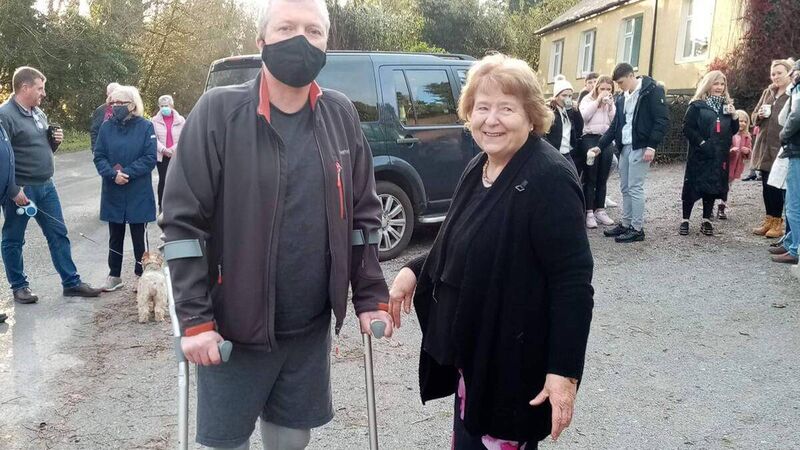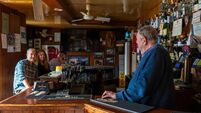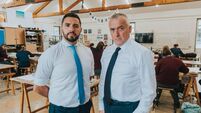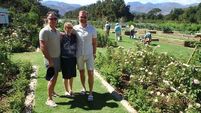Sepsis took my fingers and legs — but I’m still standing...

Barry O’Sullivan and his mother Kitty.
BARRY O’Sullivan, from Ballincurrig, will never forget February of this year, when his life changed irrevocably forever.
“I was chopping wood all day outside in the garden on the Sunday before I went into hospital,” says Barry, aged 52.
“Three days later I was in a coma. Being in a coma was the worst experience of my life.”
Barry has come a long way since he arrived at Cork University Hospital in Septic shock in February. He realises he is very lucky to be alive even though he was unlucky to lose his fingers and both his legs feet as a result of the condition.
Sepsis arises when the body’s response to infection causes organ dysfunction. It is responsible for one in five deaths world-wide.
“For the first week before Covid hit, my family were around me and they all thought I was dying,” says Barry recalling his near-death experience.
Barry’s family were prepared for the worst.
“They expected me to die. That’s what the prognosis was.
“I was screaming for help, or trying to, but I knew my mouth was full of cables just tubes and tubes and things,” he explains.
Barry feared the worst.
“When the voices disappeared, when they stopped being allowed to come in to the ICU: I thought they had all been killed.
“When I woke up, I was experiencing what’s called ICU delirium. I thought the doctors were experimenting on me, trying to kill me and all that sort of thing.”
Barry had a close shave with life and death before.
“30 years ago, in 1991, I was involved in a motorbike accident when I lost my spleen. The spleen helps fight infection in the body. I was fit and healthy for all those years since the accident.”
Then he got the shivers.
“I thought I was coming down with a cold,” says Barry.
“I went to the GP. I was freezing cold, I was wondering; how could I get warm?”
He was whisked away to CUH by ambulance where he was put into an induced coma.
“For two weeks, I knew nothing,” says Barry.
He lay helpless in his hospital bed where the only sound of the drip-drip of powerful anti-biotics going into his body broke the eerie silence.
“My muscles wasted away in those two weeks,” says Barry.
“My fingers went black, like I had frost-bite. My toes were the same. It was frightening.”
He was in a strange place.
“I was delusional from the drugs” says Barry.
“I was convinced everyone in the hospital was ‘out to get me’.
“It was very unpleasant. Coming out of the coma, I was trying to figure out; who were these people?”
Barry woke up from the coma thirsty.
“I was gasping. I couldn’t swallow water. I was given an ice-cube I thought tasted like sea water. The room was swaying. I was glad to come out of the ICU into another ward in CUH. The CUH nurses are incredible.”
He was glad to see a friendly face.
“Dr. Sadlier, Consultant for Infectious Diseases told me I was extremely lucky, to be alive,” says Barry.
“I had been in septic shock and I had come very close to death.”
He was in for another shock.
“My fingers had turned black due to not enough oxygenated blood getting to them. The blackening spread to the soles of my feet. The vascular surgeon evaluated my fingers, my toes and my legs. They couldn’t be saved”
Before any decision was made, the medical experts did the research.
“A team of vascular surgeons were tasked to do research about possible options,” says Barry.
“One option was to take a muscle from my back and transplant it to my lower limbs. That would mean things like swimming and ski-ing would be out for me. This was not an option. I had enough restrictions on what I could do as it was.
“The fingers were almost a bigger hurdle because I knew I could get prosthetic feet, but I am a person who does a lot with my hands.”
Barry previously worked as potter, he loves to garden, and he loves nature. Prior to contracting sepsis; Barry worked with SECAD Partnership CLG in Midleton as a Tus supervisor.
“Although I have quite a bit of function in my hands, that’s never going to be the same.”
The medics were unanimous that a bilateral transtibial amputation had to be carried out.
How did that make Barry feel?
“I was accepting,” says Barry.
“It was the best thing to do.”
In his former life Barry was a big outdoor man.
“I love the beach, the woods, the garden. My area of interest is bio-diversity.
“I monitor a lot of wildlife in Fota Park and nature reserves.
“My work include administration, teaching people how to monitor wildlife and appreciate nature, and a lot of walking over rough terrain. My legs were vital. I hope I can make my job workable in the near future.”
It was vital that Barry kept his in-built optimistic attitude and his positivity. He and his body were a team that worked together to overcome obstacles. The strong duo got going.
“The National Rehabilitation Centre Dun Laoghaire is a state-of-the-art facility,” says Barry.
“I had great company there.
“The gyms at the hospital are fabulous and the staff and the patients are very nice people. I got to know everyone from the medical teams, therapists, cleaning staff and tea lady.”
“The physiotherapy treatment and the occupational therapy helped me very much.”
He did other therapy.
“I did art therapy-not really for me!” says Barry laughing.
He’s more of an action man.
“I took part in archery sessions at the hospital. I’m almost as bad as I used to be!”
He met Ed Sheeran there too.
Barry laughs.
“Ed is from Mayo, a great character! And he had a good voice.”
Barry, a strong character with a strong will, began making strides to get back home in east Cork, to his beloved garden and to his loved ones.
“Li, my girl-friend, is a great help to me,” says Barry,
“I am lucky to have great support, from my mother and from my family. I have four sisters and three brothers.”
He is lucky to have great motivation.
“What motivates me is the need to get back to my life, the need to overcome this. I had to stay focused to get back on my feet. For me, that is all consuming.”
Barry with a great pair of hands and a logical brain designed his own personalised wheelchair. He’s eying up another vehicle.
“I’m looking at the ride-on mower outside,” says Barry, who has a bird’s eye view of the garden from his window.
“I think that would be a good way to get around the garden paths and spend some time outside with the dog.”
He figured out a way to drive on.
“I had my car modified adapted and I had the back seats taken. Martin a friend of mine helped me take the seats out of the car so I can pull in the wheelchair easily into the back of the car.”
Barry, full of the joys of life and grateful to be alive knows the worst didn’t come to the worst.
“The worst part mentally was being in the coma,” says Barry,
“I had a week of nightmares. I could hear the voices of my aunts and uncles, family and friends, that was woven into part of the nightmare. I looked peaceful, but I was in turmoil.
“It was an ordeal I wouldn’t want to repeat.”
Things weren’t all bad.
“I dreamt I was kidnapped by a blonde lady doctor,” says Barry laughing.
Barry spent six months in CUH and three months in the NRH.
“So many seasons passed,” says Barry.
“I suppose the worst part of it all physically is losing my fingers and toes. He’s getting back on his feet.
“I’m getting used to the prosthetics,” says Barry.
He’s getting used to the fact that the future holds great promise.
“Things can change in the blink of an eye,” says Barry.
“Now I look forward to enjoying every day. I’m just so glad to have a future.”
Barry would like to acknowledge the support of the management and staff of SECAD Partnership CLG, a local development company who were a great support to both himself and his family throughout.
ABOUT SEPSIS
Sepsis affects 30 million people a year world-wide and kills an estimated 6 million, 2 million of whom are children.
Sepsis Symptoms - spot the signs:
- Fever and chills.
- Very low body temperature.
- Peeing less than usual.
- Fast heartbeat.
- Nausea and vomiting.
- Diarrhea.
- Fatigue or weakness.
- Blotchy or discolored skin.







 App?
App?


